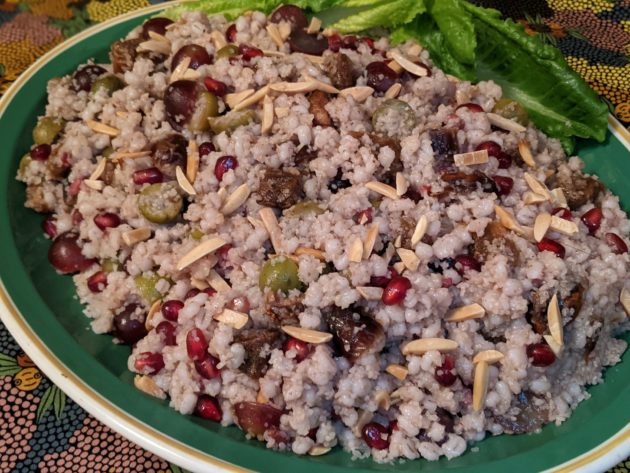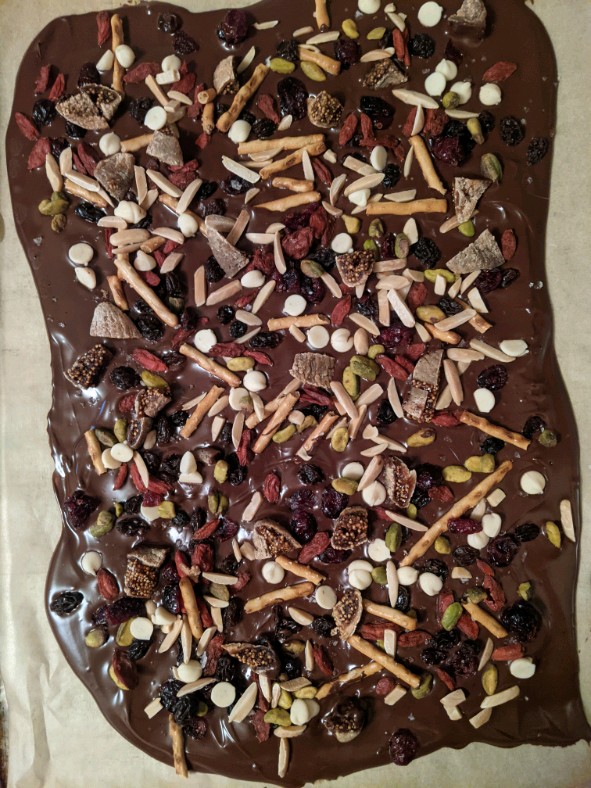
by admin
The Promise of Tu B’Shevat
Tu b’Shevat is the holiday that lets us know better days are coming.
In the midst of winter, the ground is cold and hard in many places with leafless trees silhouetted against the often-gray skies. But leafless doesn’t mean lifeless- and deep in the winter earth, things are happening. Trees and plants are awakening, gathering nutrients, making ready for the spring that is soon to come.
Tu b’Shevat (sunset to sunset, January 27-28) is the first Jewish holiday that honors the environment and guides us to take care of the earth and all that grows from it. Also called the new year of trees, the holiday’s timing is based on the biblical land of Israel’s Mediterranean climate and agricultural calendar. This is when almond trees blossom and farmers plant seeds for spring crops. In ancient times, fruit trees were counted for taxation purposes and to ensure there were enough that survived since the last growing season.
The seven species found in Torah have come to be associated with Tu b’Shevat. After 40 years of wandering in the desert, the people were finally able to see the land of Israel. Moses sends out scouts to discover what awaits his people. When they return, Moses is able to tell them that:
“…the Lord your God is bringing you into a good land…a land of wheat and barley, of vines, figs and pomegranates, a land of olive trees and honey.”
Deuteronomy 8:7-8
These are the seven species that sustained the ancient people of Israel and remain important crops for the country today. Given the timing of the blooming trees, almonds are considered the eighth species.
As I write this, I feel, as so many of us do, the weight and worry of this time of great upheaval and terrible divisions in our country. Our world is also under siege by a deadly virus. Too often these days it seems we are wandering in the wilderness, lost and afraid.
But beneath all of this, there is hope stirring, from changes in leadership to vaccines to communities and organizations coming together to help take care of people. Perhaps we can create our own seven species…qualities for this time to help us focus on what we need to find in abundance within ourselves and each other to sustain us through these dark days as we grow a new, better future. Qualities like gratitude, communication, understanding, patience, compassion, kindness and love. And for the special eighth component, willingness to look for and embrace these in qualities our lives.
I am not given to chasing windmills or Pollyanna dreams, but I do strive to live in hope. It’s a survival technique during long, dark winters, both physical and spiritual. Tu b’Shevat, which grounds us in the earth’s natural cycles, is a time to ready the world for new growth, the fulfillment of the promise that better days are coming.
Recipes developed by Susan Barocas

SEVEN SPECIES SALAD
Use more or less of the figs, dates, grapes, olives and pomegranate to your taste. Served as a main or side dish or appetizer, the salad is terrific for holiday meals or buffets, especially when feeding a crowd.
Makes 8-10 main or 14-18 side servings.
- 1 cup barley (4 cups cooked)
- 1 cup bulgur wheat (3 cups cooked)
- 1 cup seedless grapes, red or green or a mix, or 1/3 cup golden raisins
- 6-8 dried black, brown or other figs of choice, depending on size (about ¾ cup chopped)
- 10-12 whole pitted dates (3/4 cup chopped)
- 1 cup pitted Mediterranean green olives or olives of your choice
- 1 small to medium pomegranate
Dressing
- 1/2 cup wine vinegar
- 1 tablespoon honey
- 2 teaspoons sumac*
- 1 teaspoon salt
- 1/2 teaspoon black pepper
- 1/3 cup olive oil
- Juice from the pomegranate
- 1/4 cup toasted almond slivers or more to taste
Cook barley and bulgur according to package directions. Let cool and place both in a large mixing bowl. Mix grains together gently with a large spoon. (Either or both the barley and bulgur can be prepared in advance and refrigerated for up to 3 days until you are ready to make the salad.)
To make the salad, cut grapes in half around the middle circumference. If using raisins, soak in 1 cup very hot water for 10-15 minutes while preparing other ingredients. Remove any stems on the figs and cut each into 4-6 smaller pieces, depending on size of the figs. Chop dates into pieces similar to figs. Drain olives and cut in half around the circumference or smaller slices as desired. Add grapes or raisins, figs, dates and olives to grains and gently mix to blend.
Cut pomegranate in half around the middle circumference. To remove the arils (seeds), firmly hold one half with the cut side facing down into your palm, leaving some space between your hand and the fruit. Hold the pomegranate over a large bowl and use the back of a wooden spoon to very firmly hit the skin of the pomegranate all around the sides, causing the arils to fall out into your palm. Let them drop into the bowl as you continue working your way around all parts of the pomegranate skin until the half is empty of arils. Repeat the process with the other half. Pick out any pieces of white membrane that have also fallen out. Gently mix most of the pomegranate arils into the other ingredients, reserving a few tablespoons for garnish. Save any juice in the bowl for the dressing.
To make the dressing, put all ingredients in a glass jar, cover tightly and shake vigorously for at least a minute until the dressing emulsifies. Pour about half of the dressing over salad and mix gently, blending well. Add more as desired. If you do this at least an hour before serving, the grains have time to soak up the dressing and you might want to add more before serving.
Serve in a large bowl or rimmed platter lined with lettuce leaves with the salad mounded on top. Sprinkle reserved pomegranate arils and toasted almond slivers before serving. For an appetizer, put a teaspoon of the salad on the ends of endive leaves, arrange on platter, sprinkle with pomegranate arils and serve. The prepared salad will keep for several days in the refrigerator.
*Sumac is a tangy spice used for centuries in Middle East cuisines. It is made from dried small clusters of red berries from flowering shrubs or small trees that grow wild in northern Israel-southern Lebanon. It is also native to parts of North America. Sumac contains a lot of nutrients and antioxidants.
CHOCOLATE BARK

Easy to make, chocolate bark can fit your mood, a special occasion, a holiday, with gifting in mind or just because. Depending on your ingredients, it can gluten-free, kosher for Passover, part of mishloah manot for Purim, dessert for Shabbat, mailed in a care package or kept around for that bit of after-dinner chocolate. It’s worth using good chocolate – dark, milk or white, or use one for bark and another as a drizzle on top. My favorite is at least 60 percent dark chocolate with no emulsifiers, but if needed, use whatever chocolate chips, chunks or bars you have.
As for toppings, there are endless possibilities and combinations! Think about all kinds of nuts and seeds (I prefer mine toasted, but that’s up to you), dried fruit, shredded or flaked coconut, candied ginger, sprinkles, crushed candies or chopped cookies, salty components like pretzels…see what I mean? All you have to do is figure out the combination you like in the moment or maybe just what you have on hand. It’s a perfect treat to make with kids. Just don’t forget the sprinkling of salt at the end for a finishing touch and to have fun making it.
- 12 ounces chocolate, chopped bars or chocolate chips (about 2 cups)
- About 1 cup toppings (see above)
- Sprinkling of regular or flaky sea salt
Cover a large baking sheet with parchment paper. Have a rubber, silicone or offset spatula at the ready.
There are two ways to melt the chocolate. I prefer making a double boiler from a metal bowl set over a couple of inches of water simmering in a pot. Be careful the water doesn’t touch the bottom of the bowl.
For the second method, the microwave, melt the chocolate in a microwave-safe bowl in 2 or 3 30-second intervals, stirring after each. With either method, stop the melting process when the chocolate is nearly all melted, then stir off the heat to incorporate any un-melted pieces until the chocolate is evenly smooth.
Once the chocolate is ready, use the spatula to quickly spread it evenly to about 1/4-inch thick or as thick as desired. Working quickly, scatter the toppings all over the warm chocolate. Pat gently to set the toppings, then sprinkle with salt lightly all over.
Set the tray in a cool place until the chocolate hardens. Let the chocolate cool at room temperature for a couple hours as long as your room isn’t too hot. You can place the pan on a flat surface in the refrigerator to speed the process. Once the chocolate is completely hardened, break it up with your hands into pieces of various sizes. Store in an airtight container in a cool place or the fridge for several weeks, although it never lasts that long.
STUFFED DATES
Filling #1 (Dairy)
- 3 ounces goat cheese, mascarpone or feta, softened at room temperature
- 1–3 tablespoons milk or cream as needed
- Pinch of salt
Filling #2 (Parve)
- 14-16 whole raw walnuts or almonds (double if smaller almonds)
For both versions
- 14-16 large, soft Medjool dates, preferably pitted
- 2-3 tablespoons honey or date syrup
- Couple pinches good sea salt or flaked salt
- 2 tablespoons pomegranate arils (seeds)
- 1-2 tablespoons sesame seeds or chopped pistachios or walnuts
Remove any remaining stems on the dates. If the dates are not pitted, use a sharp, pointed paring knife to carefully make a slit about 3/4 across the length of each. Use the knife point to slip the pit out.
Filling #1
Put cheese into a bowl. Add milk or cream and salt, then mash and beat mixture by hand with a fork until smooth, adding more milk or cream to create a creamy mixture. Fill each date with a heaping teaspoon of cheese so it overflows the top of the date, using either a small spoon or put the filling in a sealed plastic bag, cut off a small bit of a corner of the bag and piped the filling into the date.
Filling #2
Slip a whole nut into each date. If the nuts are small or the dates are especially big, add another nut so the opening is full. Arrange on a serving dish. Just before serving, sprinkle lightly with salt, drizzle with honey or date syrup and scatter pomegranate seeds, chopped nuts and/or sesame over all the dates.
To Serve
Arrange on a serving dish. Just before serving, drizzle with honey or date syrup, sprinkle lightly with salt and scatter pomegranate seeds, chopped nuts and/or sesame seeds over all the dates.